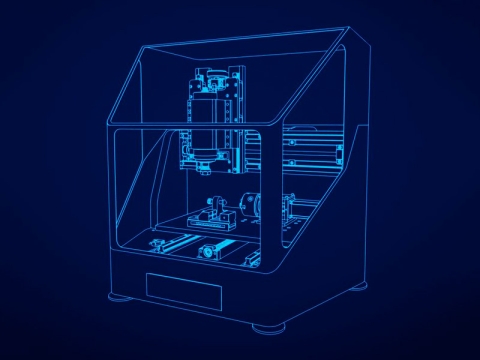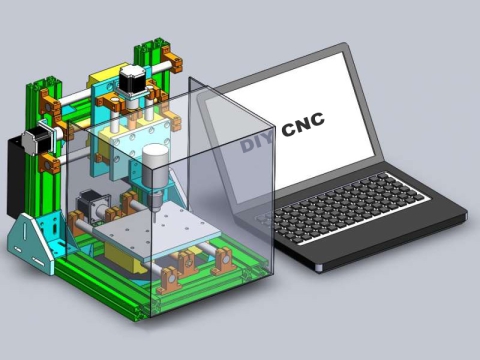How To Use A CNC Milling Machine: Step-by-Step Instructions
CNC mills are computer numerical controlled milling machines, which come with 3, 4 or 5 axes to perform milling job simultaneously.
CNC milling machine is a high-precision metal fabricator with a high-speed spindle, high-power servo motor and heavy-duty machine bed structure, which works similar to a CNC machining center and can perform centralized machining of milling, drilling, boring, reaming and tapping.

A CNC milling machine uses a computer to control program operation, drive the machine to work, and achieve the final milling job. Therefore, if beginners want to learn how to easily operate a CNC mill, they need to have certain basic knowledge of computers and CNC.
Newbies are struggling with the right operating steps, and CNC machinists are wandering on the road to advancement. How to find the best operating instructions?
Here are 9 easy-to-follow steps to operate a CNC milling machine with ease, whether you are a beginner or a professional.
CNC Milling Machine Operating Steps
Step 1. Turn back to the reference point
Step 2. Move the machine table to the middle of the machine (press the negative key, otherwise it will overtravel), and place the workpiece on the table.
Step 3. Use a dial indicator to align, and then clamp the workpiece (if the workpiece permits, it can be milled after clamping, then the dial indicator is no longer used to align); if you use flat-nose pliers, you must 1st correct the jaws.
Step 4. Tool setting: the spindle is equipped with a tool setting instrument, the spindle rotates forward (the photoelectric tool setting instrument does not rotate), 1st X direction tool setting, rotate (press) the operation interface to the hand wheel, 1st move the tool to the right end of the workpiece, then— Slowly approach the workpiece in the X direction until it is accurate, lift the tool in the Z direction (X direction cannot be moved), clear the relative coordinates in the X direction, and then move the tool to the left end of the workpiece, then slowly approach the workpiece in the + X direction until accurate, lift the tool in the Z direction (Cannot move in X direction), remember the relative coordinate value in X direction at this time, divide it by 2 to get a value, and then move this value in + X direction, record the machine coordinate at this time accurately, and fill in the workpiece In the coordinate system.
Step 5. In this way, set the tool in the Y direction from + Y to -Y.
Step 6. Z-direction tool setting: use feeler gauge, measuring rod, Z-direction setting tool, etc. to set the tool, after accurate, add a negative value to the current machine coordinate value (feeler gauge, measuring stick, Z-direction setting device, etc.) The thickness is filled into the workpiece coordinate system.
Step 7. If you are running a manually edited program, you must also fill in the tool radius compensation value into the tool compensation.
Step 8. Run manual programming: call up the program, press automatic, press single segment, and then press cycle to start.
Step 9. Run automatic programming: press DNC (Direct Numerical Control), press single segment, press cycle to start, and the communication software on the PC press send.
CNC Milling Machine Operating Rules
⇲ The operator should be familiar with the composition, structure and use environment of the CNC milling machine used, and strictly operate in accordance with the requirements of the operating manual of the machine tool, and try to avoid failures caused by improper operation.
⇲ When operating the machine tool, dress correctly as required.
⇲ Remove obstacles and measuring tools on the workbench, guide rail, sliding surface, etc. before starting, and remove the clamping tool in time. Check whether mechanical, hydraulic, pneumatic and other operating handles, valves, switches, etc. are in the non-working position, and check whether the knife holder is in the non-working position. Check whether the oil in the box is within the specified scale, and add oil according to the lubrication chart or manual.
⇲ Turn on and off in sequence, turn on the CNC machine 1st and then turn on the CNC system, turn off the CNC system 1st and then turn off the machine tool.
⇲ After turning on the machine, return to the reference point to establish the machine coordinate system.
⇲ When manually moving the table along the X and Y axis directions, the Z axis must be at a safe h8 position, and pay attention to observe whether the tool moves normally during the movement.
⇲ Correctly set the tool, determine the workpiece coordinate system, and check the data.
⇲ After the program is input, it should be carefully checked, including checking the code, instruction, address, value, sign, decimal point and grammar to ensure that it is correct.
⇲ After the program is debugged, before the formal cutting process, check again whether the program, tool, fixture, workpiece, parameters, etc. are correct.
⇲ After the tool compensation value is entered, the tool compensation number, compensation value, sign, and decimal point should be carefully checked.
⇲ Clamp and use cutters in accordance with technological regulations and procedures. Before performing formal machining, the entered programs and parameters should be carefully checked, and the test run of the program should be conducted to prevent the collision between the tool and the workpiece during processing and damage to the machine tool and tool.
⇲ When clamping the work piece, check whether the jig interferes with the movement of the tool.
⇲ During trial cutting, the feedrate override switch must be turned to low gear. When the tool travels to the workpiece 30-50mm, it must be under feed hold to verify whether the remaining coordinate values of the Z axis and the X and Y axis coordinate values are consistent with the processing program data.
⇲ After sharpening the tool and changing the tool, the tool length should be re-measured and the tool offset value and tool offset number should be modified.
⇲ After the program is revised, the revised part should be carefully calculated and carefully checked.
⇲ During manual continuous feed operation, you must check whether the positions selected by various switches are correct, determine the positive and negative directions, and then perform the operation.
⇲ Allow the machine to run idle for more than 15 minutes after turning it on so that the machine can reach thermal equilibrium.
⇲ After the machining is completed, move the X, Y, and Z axes to the middle position of the stroke, and set the spindle speed and feed rate override switches to the low gear position to prevent the machine tool from erroneous operation due to misoperation.
⇲ Once abnormal conditions are found during the operation of the machine tool, the red emergency stop button should be pressed immediately to terminate all movements and operations of the machine tool. After troubleshooting, the machine can be operated again and the program can be executed.
⇲ When loading and unloading the knife, hold the tool handle first, and then press the tool change switch; when installing the tool, release the handle after confirming that the tool handle is fully seated and tightened. It is forbidden to run the spindle during the tool change.
⇲ When a machine tool alarm occurs, the cause should be ascertained based on the alarm number and eliminated in time.
⇲ With the permission of the teacher, the U (hard) disk and CD-ROM are not allowed to be inserted into the computer networked with the CNC machine tool, and it is not allowed to modify or delete the programs in the computer.
⇲ After processing, clean the site, clean the iron filings of the CNC machine tool, wipe the rail surface clean, oil and prevent rust.
Things To Consider
In short, being proficient in operating a CNC milling machine is not something that can be achieved overnight. It requires accumulated practical work over a period of time to transform from a novice to an experienced expert. Be sure to remember not to rush for quick success.





